Papers by nanda gunawardhana

Journal of Photochemistry and Photobiology A-chemistry, Jul 1, 2017
Abstract This paper describes the use of ball-milled vein graphite and ball-milled floated graphi... more Abstract This paper describes the use of ball-milled vein graphite and ball-milled floated graphite counter electrode (CE) materials in dye-sensitized solar cells. The vein graphite used was ball milled, sieved and fraction of particle sizes in the 45–63 μm was used (BMG). Another fraction in the same size range was floated in water to get ball-milled floated graphite (BMFG). Both samples were extensively characterized by electrochemical techniques, Raman spectroscopy and by Total Carbon Analysis. The performance of dye-sensitized solar cells (DSCs) prepared using these CEs were optimized for their adhesion, sintering temperature and thickness. Best performances were obtained for the DSC with CE prepared using graphite:morphol mass ratio of 5:3, sintering temperature of 350 °C and the thickness of 250 μm. Most of the impurities in ball-milled graphite can be removed by the floating technique and the DSC fabricated with ball-milled floated graphite based CE gives 24% better performance than that constructed using just ball-milled graphite based CE. The best conversion efficiency observed is 6.47%. Though this is less than that obtained using Pt CE, it is still very useful in practical applications as per cost considerations.
Social Science Research Network, 2022
Materials Research Bulletin, Oct 1, 2022
Diamond and Related Materials, Dec 1, 2021

Journal of Electronic Materials, 2021
A simple low-cost method to enhance the electrical properties including open-circuit voltage (VOC... more A simple low-cost method to enhance the electrical properties including open-circuit voltage (VOC), flat-band potential (Vfb) and short-circuit current (ISC) in the photoelectrochemical (PEC) cell of cadmium sulfide (CdS) thin films is presented. The PEC cell properties were determined using the configuration Pt/0.1 M Na2S2O3/CdS. Three different sets of CdS thin films were grown: (a) chemical bath-deposited CdS (CBD-CdS), (b) electrodeposited seed-assisted CBD-CdS (ED/CBD-CdS) and (c) ED/CBD-CdS deposited under the presence of ethylenediaminetetraacetic acid (EDTA) in a reaction solution of CBD (ED/(CBD+EDTA)-CdS). The FE-SEM images suggested the formation of clusters with spherical shape in the presence of a seed layer. All the samples grown with seed layers demonstrated improved ISC and VOC values in the PEC cell compared to the CBD-CdS films due to better contact between the substrate and CBD-CdS. Furthermore, the carrier concentration (ND) and Vfb were also found to improve due to the introduction of the seed layer. In the case of ED/(CBD+EDTA)-CdS, the cluster size was found to be smaller, giving rise to a larger effective surface area. The improved effective surface area, interparticle connections and adhesion of CdS to the FTO substrate resulted in superior electrical properties of ED/(CBD+EDTA)-CdS compared to ED/CBD-CdS and CBD-CdS films.
Journal of Materials Science: Materials in Electronics, 2020
Chemical Communications, 2012
Instrumentation Science & Technology, 2021
An automated instrument to measure specific surface area (SSA) of powdered materials was designed... more An automated instrument to measure specific surface area (SSA) of powdered materials was designed using the Brunauer–Emmett–Teller (BET) isotherm method. A sample of known SSA was introduced to mak...
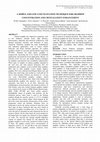
Natural graphite has impressive properties such as low hardness, metallic luster, high lubricity,... more Natural graphite has impressive properties such as low hardness, metallic luster, high lubricity, refractoriness, high-heat and electrical conductivity with thermal resistance, inertness and resistance to many chemicals. Therefore, graphite has many technological and industrial applications such as motor vehicle lubricants and shock absorber materials. Sri Lankan graphite is mainly of vein type and the purities range from 90-100%. Demand for high purity graphite is progressively increasing due to its variety of traditional applications and predicted novel applications. Herein, we describe novel, low-cost and simple flotation technique for graphite concentration and crystallinity enhancement. Three types of samples (a) impure graphite (attached to the wall rock and with mineral inclusions, IG), (b) moderately pure graphite (coarse-striated flaky graphite, MG) and (c) pure graphite (coarse shinny slippery graphite, PG) were collected from Bogala Mines Ltd. and broken into small chips ...
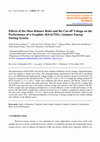
The performance of KS-6/TiO 2 full cell has been studied at different cutoff voltages, charge/dis... more The performance of KS-6/TiO 2 full cell has been studied at different cutoff voltages, charge/discharge rates and cathode to anode mass ratios. The charge/discharge mechanism of the full cell is elucidated by ex-situ XRD data and analyzing the voltage profiles of each electrode by means of 4-electrode cell. Capacity retention of the cell between the 3 rd and 50 th cycles is 95.5 % though the ceiling potential of KS-6 exceeds 5.1 V vs. Li/Li +. Under such conditions this device delivers 100 Wh.kg-1 based on the total weight of the cathode and anode materials. Thus the energy density of this device is higher than AC/TiO 2 type capacitors due to the higher working voltage and capacity of the KS-6 cathode. The KS-6:TiO 2 weight ratio and charging potential have a crucial influence on the overall performance of this device. The KS-6/TiO 2 weight ratio could be increased up to 2 without a significant capacity fade of the cell in the voltage window 1.5-3.5 V. These results demonstrate that the electrolyte could be used as the sole source of Li + allowing development of novel type of energy storage devices without lithium rich cathodes as the lithium source.
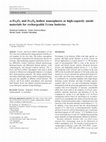
Ionics, 2012
α-Fe 2 O 3 and Fe 3 O 4 hollow nanospheres of size 30±2 nm were synthesized by using polymeric mi... more α-Fe 2 O 3 and Fe 3 O 4 hollow nanospheres of size 30±2 nm were synthesized by using polymeric micelles as a soft template for the first time. The hollow nanospheres were thoroughly characterized by transmission electron microscope, superconducting quantum interference device, Xray diffraction, Fourier transform infrared spectroscopy, thermogravimetry and differential thermal analysis, cyclic voltammogram, and nitrogen sorption analyses. The α-Fe 2 O 3 and Fe 3 O 4 hollow nanospheres were used as anode materials in lithium-ion rechargeable batteries to investigate their electrochemical properties. The hollow particle-based electrodes exhibit high capacity, stable cycling performance, and good rate capability at different current densities. The α-Fe 2 O 3 and Fe 3 O 4 hollow nanospheres with nanosized shell domain favors fast lithium insertion/extraction processes during the repeated charge/discharges.

Electrochimica Acta, 2014
ABSTRACT Mesoporous polythiophene birnessite (b)-MnO2 has been synthesized by a modified interfac... more ABSTRACT Mesoporous polythiophene birnessite (b)-MnO2 has been synthesized by a modified interfacial method to develop cathode electrode materials for lithium batteries. The N2 adsorption/desorption isotherm test of mesoporous polythiophene MnO2 shows a type IV hysteresis loop, which is characteristic of a mesoporous structure. Mesoporous polythiophene MnO2 has a high surface area of 226 m2 g−1 with a pore diameter of 5.2 nm The mesoporous polythiophene b-MnO2 cathode electrode for Li-ion battery exhibited an initial discharge capacity of 305 mAh g−1 at a current density of 10 mA g−1, which is almost equal to its theoretical capacity. When applying a current of 300 mA g−1, mesoporous polythiophene MnO2 electrode shows the initial discharge capacity of 211 mAh g−1, which is 69% of its theoretical capacity. Mesoporous polythiophene MnO2 shows high capacity and good cycle stability even at high current densities due to its high surface area and fast Li-ion diffusion path.
Chemistry Letters, 2012
ABSTRACT CeO2 hollow nanospheres were synthesized using polymeric micelle poly(styrene-block-acry... more ABSTRACT CeO2 hollow nanospheres were synthesized using polymeric micelle poly(styrene-block-acrylic acid-block-ethylene oxide) with core shell corona architecture. The CeO2 hollow nanospheres were investigated as anode materials for rechargeable lithium ion batteries for the first time. The nanostructured electrode shows desirable electrochemical properties such as high capacity, good capacity retention, and rate performance.
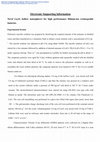
Chemical Communications, 2012
Novel La 2 O 3 hollow nanospheres for high performance lithium-ion rechargeable batteries Experim... more Novel La 2 O 3 hollow nanospheres for high performance lithium-ion rechargeable batteries Experimental Section Polymeric micelles solution was prepared by dissolving the required amount of the polymer in distilled water and then transferred to a volumetric flask to obtain a stock solution with a concentration of 0.5 gL-1. The micelle solution was adjusted to pH 9 by using dilute NaOH. The micelle solution (10 mL) was stirred for a few minutes followed by addition of desired amounts of LaCl 3 .7H 2 O (LaCl 3 /PAA = 5 to 12) under vigorous stirring. Then La 3+ was precipitated as La(OH) 3 by further increasing the pH to about 11. The composite particles were aged for 4 days without agitation and repeatedly washed with hot distilled water and ethanol and then dried at 60 °C. In order to remove the polymeric template as well as to crystallize the La 2 O 3 hollow particles, the composite particles were heated to 550 °C for 4 h in a muffle furnace under air. For lithium ion alloying/de-alloying studies, 5.0 mg of the hollow La 2 O 3 was mixed well with 5.0 mg of teflonized acetylene black (TAB-2,) and then the mixture was pressed on a stainless steel mesh as the current collector under a pressure of 500 kg/cm 2 and dried at 160 °C for 5 hours under vacuum. The electrochemical characterizations were carried out using CR-2032 coin type cells with lithium as anode. The electrolyte used was 1M LiPF 6-EC:DMC (1:2 by volume, Ube Chemicals Co. Ltd.). The coin cell assembling was performed in a glove box filled with argon (dew point, lower than −80). The galvanostatic charge-discharge tests of the coin cell were performed at the constant current density 300 mA.g-1. For the cyclic voltammograms 2.0 mg of La 2 O 3 was mixed with 2.0 mg of TAB-2. Lithium foils were used as reference and counter electrodes. Scan rate is 20 mV/min in the range of 0.005-3.0 V vs Li/Li +. Characterization: Powder X-ray diffraction (SXRD) patterns were collected on a Rigaku Rintultima diffractometer with CuKα radiation (40 kV, 20 mA) from 0.7° to 5° 2θ in 0.01 steps at a scan Electronic Supplementary Material (ESI) for Chemical Communications This journal is © The Royal Society of Chemistry 2012 speed of 1° min-1 and wide-angle XRD was performed on a Shimadzu XRD-7000 (WXRD) diffractometer. N 2 adsorption/desorption analyses were carried out by using a Quantochrome (Autosorp 1C) apparatus. DLS measurements were carried out with an Otsuka ELS-8000 electrophoretic light scattering spectrophotometer. The TEM pictures were recorded on JEOL JEM-1210 (80 kV) and JEM-2100 (200 kV) electron microscopes. Fourier-transform infrared (FTIR) spectra were recorded on a Jasco FT/IR 7300 spectrometer. Thermogravimetry and differential thermal analysis (TG-DTA) were obtained with a MAC Science TG-DTA 2100 instrument under air. Galvanostatic charge-discharge measurements were performed on a BTS 2004 equipment, Nagano charge/discharge instrument. CV measurements were performed using an HSV-100 appratus (Hokuto Denko Ltd., Japan).
Abstract. A full cell has been developed using KS-6 and hollow titania nanosphere as cathode and ... more Abstract. A full cell has been developed using KS-6 and hollow titania nanosphere as cathode and anode materials, respectively, by using 1:1 weight ratio of cathode to anode materials. Thus developed energy storage system exhibits enhanced voltage up to 5.3 V vs. lithium without causing any safety issues. Since the anode is free from lithium deposition the safety of this energy storing device is expected to be very high. The charge/discharge mechanism of the present system exclusively based on intercalation and de-intercalation of PF6 anion at the cathode (KS-6) and Li cation at the anode (hollow titania nanosphere) materials, respectively. In addition, hollow titania spherical structure enhances the rate performance of the device.
A great number of universities worldwide are having their education interrupted, partially or ful... more A great number of universities worldwide are having their education interrupted, partially or fully, by the spread of the novel coronavirus (COVID-19). Consequently, an increasing number of universities have taken the steps necessary to transform their teaching, including laboratory workshops into an online or blended mode of delivery. Irrespective of the measures taken, universities must continue to maintain their high academic standards and provide a high-quality student experience as required for delivery of learning outcomes associated with each degree programme. This has created a challenge across the higher education landscape, where academics had to switch to remote teaching and different approaches to achieving laboratory delivery.
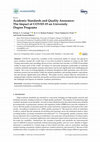
Sustainability
COVID-19, caused by a member of the coronavirus family of viruses, has spread to most countries a... more COVID-19, caused by a member of the coronavirus family of viruses, has spread to most countries around the world since it was first recorded in humans in China in late 2019. Closing universities and cancelling all face-to-face activities have become a COVID-19 inevitable reality in many parts of the world. Its impact on university programs, particularly to maintain academic standards and quality assurance procedures, has become significantly more challenging and complex. New ways of working digitally, to minimize disruption to daily operations, have also led to enormous anxiety and uncertainty within the student population, and meeting students’ expectations has also become significantly more difficult. This paper reviews actions taken by universities to safeguard high academic standards and quality assurance procedures during this time and appraise the challenges and impacts on students’ academic performance.










Uploads
Papers by nanda gunawardhana